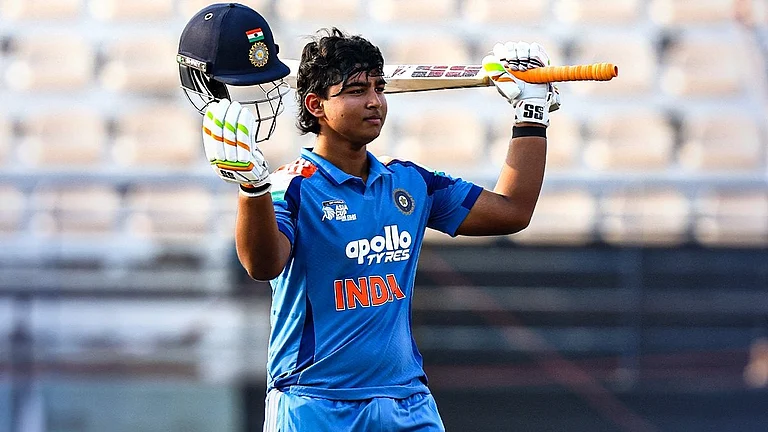We boarded a train from Delhi to Lalitpur, the nearest junction to Chanderi, on an ordinary August evening. Monsoon, perhaps, is the best season to visit Madhya Pradesh. The countryside, which is rendered dry and dusty-brown during the preceding summer months, transforms into a verdant landscape under the spell of heavy rains. Chanderi, a small picturesque town in Madhya Pradesh, lends its name to the popular handwoven sarees it exclusively produces. But, many will be surprised to find that the town has much more to offer than sheer, gossamer textiles.
The town piqued my interest a few years ago. I had been curious to visit the place, for, despite its rich history, Chanderi seldom features as a popular travel destination among heritage enthusiasts. So last year, when a friend asked if I wanted to travel to Chanderi on her birthday, I responded with a resounding yes.
An hour-long bus ride from Lalitpur to Chanderi rewarded us with spectacular views of the beautiful green fields and forests on either side. Once in Chanderi, we made our way to the centre of the town. We were lucky to have reached Chanderi on a Saturday, and experienced the extensive weekly market. If sources on the internet are to be believed, then present-day Chanderi dates back to the 11th century. But its history is more tumultuous and traces its roots in mythology and folklore as well. According to a legend, the city was established by lord Krishna’s cousin, king Shishupala, in the Vedic period. Another one suggests that king Kirtipal of the Gurjara-Pratihara dynasty shifted the capital from Buddhi (old) Chanderi, a site that still exists some 16 kms away from the current settlement, and which is home to over 55 Hindu and Jain temples. However, since its establishment, Chanderi has seen many dynasties rise and fall — the Kachhwahas, the Mamluks, the Malwa Sultanate, the Mughals and the British — all leaving behind marks on its architectural landscape. The importance and prosperity of Chanderi can also be noted in various travel accounts by famous chroniclers, among whom was Ibn Battuta, who visited the city in 1342. He described Chanderi as a thriving, culturally rich city that had huge bazaars teeming with people and goods.

***
Having had our fill of the sights and sounds of the market, we met with a friend, Saiful Islam, a resident of Chanderi and young master weaver who enthusiastically offered to take us around town. Together, we made our way to the sprawling Chanderi Fort complex called the Kirti Durg. Perched on a hilltop, it offers breathtaking views of Chanderi and its surrounding forests and fields. Built in the 11th century by king Kirtipal, the fort is also an amalgamation of the different cultural and architectural elements that each conqueror brought with them. There is the Naukhanda Mahal with a central courtyard, fountain, and tank, which was built by the Bundela king, Durjan Singh, in the 16th century. Also present is a mosque with intricate stone carvings featuring floral patterns and verses from the Quran built by Alauddin Khilji. Some parts of the complex have a more gory history. For instance, the Johar Smarak, which was built to commemorate the mass immolation of 600 Rajput women in 1528, when Babur attacked the kingdom. Then, there’s Khooni Darwaza, where the Malwa sultans would hang the bodies of prisoners, and which is said to have literally been bathed in blood again when Babur laid siege to the fort. In a way, the fort is a metaphor for Chanderi itself — it is peppered with numerous historical sites from different periods and warrants plenty of time to explore each of them leisurely.
Over the course of the next day, Saiful continued to guide us through more of these sites — the forlorn Raja Rani Mahal, one of the 43 remaining palaces in town, the domeless Shehzadi ka Rauza, built in the 15th century by the governor of Chanderi for his daughter, Mehrunissa, and Parmeshwar Tal and its surrounding cenotaphs of the Bundela kings and their satis.

***
Apart from the royal vestiges scattered across its landscape, Chanderi and its environs have been a hub of great religious and spiritual activity. Under the Gurjara-Pratihara dynasty, and during the rule of the Kachhwahas, many Hindu and Jain temples were built in the area. Later, Sufism was woven into the spiritual fabric of the city. To help us see the area through this lens, we met Muzzafar Ansari, popularly known as Kalle bhai, a historian, guide and expert on all things Chanderi. Kalle bhai's penchant for history and storytelling not only helped us see places we had come across before in a new light but also introduced us to some undiscovered gems.
An example of the former is the beautiful complex of Nizammudin Family Tombs. A popular tourist spot managed by the Archaeological Survey of India, we chanced upon it while aimlessly walking through the streets of Chanderi. What lay inside were stone graves with astonishingly intricate carvings. Some were housed under domes (while others lay under the open sky), and were adorned with geometrical carvings and jaali work. Kalle bhai pointed out that family also refers to a silsila or sect of followers. Thus, the graves here are of the followers of the Chishti Nizami sect, which was established when Nizammudin Auliya sent his khalifas to the Malwa region to establish the order.

The khalifa who was sent to Chanderi was Hazrat Wajihuddin Yusuf. Hailing from Kilokari (an area that still exists in Delhi), Hazrat Wajihuddin made his way to Chanderi in 1305 to serve the people there and garnered many followers. We visited his dargah — a pristine, white-and-lime-green structure with a dome on top which houses his grave.
***
Gauging our unending curiosity about history and heritage, Kalle bhai promised to take us to another hidden gem — this time some 50 kms from Chanderi. So, even though my friend and I were both overwhelmed and slightly tired by now (it had been three long days of exploring, after all), we agreed to go on one last excursion before we headed back to Delhi. A long, scenic drive later, we reached Kadwaya, a village dating back to the 8th century CE. On the surface, Kadwaya looks like any other village you would come across in north India — narrow lanes dotted with old, brightly painted houses, small shrines and shops — but it boasts of 15 Hindu temples, a monastery, a fort and tanks from the 8th century CE. We passed by many of these to stop at the grandest of them all, the Toteshvar Mahadev temple. Although many historic temples are no longer worshipped at, Toteshvara Mahadev is an exception to the rule.

By the time we reached the temple, a group of women was already praying there. Singing a folk bhajan in unison, they were offering freshly collected flowers and milk to the Shiva lingam. Witnessing the hypnotic scene made me reflect on what we had encountered on our trip. The small city of Chanderi, and even smaller Kadwaya, seemed surreal — full of unimaginable treasures yet waiting to be (re)discovered.





















